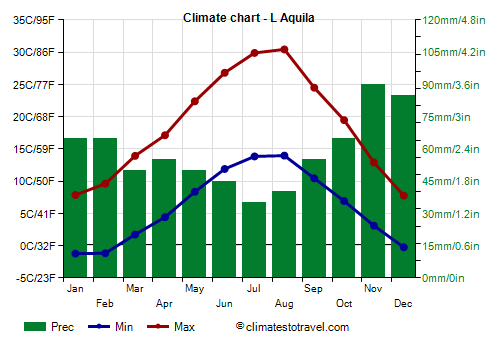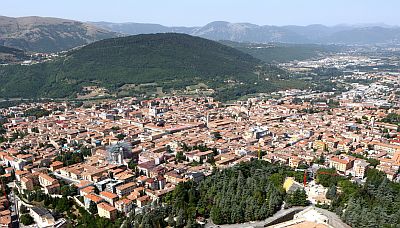Select units of measurement for the temperature and rainfall tables (metric or imperial).
Average weather, temperature, rainfall, sunshine hours

The climate of L'Aquila is
slightly continental, with quite cold winters and warm to hot summers.
The city is the capital of the Abruzzo region and is located in the center of Italy, in a valley at 700 meters (2,300 feet) above sea level.
The
average temperature of the coldest month (January) is of 3.3 °C (37.9 °F), that of the warmest month (August) is of 22.2 °C (72 °F). Here are the average temperatures.
L Aquila - Average temperatures (1991-2014) |
| Month | Min | Max | Mean |
|---|
| January | -1.2 | 7.9 | 3.3 |
|---|
| February | -1.2 | 9.6 | 4.2 |
|---|
| March | 1.7 | 13.9 | 7.8 |
|---|
| April | 4.4 | 17.1 | 10.8 |
|---|
| May | 8.4 | 22.4 | 15.4 |
|---|
| June | 11.9 | 26.8 | 19.3 |
|---|
| July | 13.8 | 29.9 | 21.9 |
|---|
| August | 14 | 30.4 | 22.2 |
|---|
| September | 10.4 | 24.5 | 17.5 |
|---|
| October | 6.9 | 19.5 | 13.2 |
|---|
| November | 3.1 | 12.9 | 8 |
|---|
| December | -0.2 | 7.8 | 3.8 |
|---|
| Year | 6 | 18.6 | 12.3 |
|---|
amounts to 705 millimeters (27.8 inches) per year: so, it is at an intermediate level. It ranges from 35 mm (1.4 in) in the driest month (July) to 90 mm (3.5 in) in the wettest (November). Here is the average precipitation.
L Aquila - Average precipitation| Month | Days |
|---|
| January | 65 | 8 |
|---|
| February | 65 | 8 |
|---|
| March | 50 | 8 |
|---|
| April | 55 | 9 |
|---|
| May | 50 | 8 |
|---|
| June | 45 | 6 |
|---|
| July | 35 | 5 |
|---|
| August | 40 | 5 |
|---|
| September | 55 | 6 |
|---|
| October | 65 | 8 |
|---|
| November | 90 | 10 |
|---|
| December | 85 | 10 |
|---|
| Year | 705 | 91 |
|---|
The
winter, from December to February, is quite cold, and characterized by sunny periods alternating with rainy periods.
Due to its position in a valley, between the Ocre and Velino mountains to the south and the Gran Sasso massif to the north, cold air tends to stagnate and often a
thermal inversion is formed, which is why the temperatures often drop below freezing during the night, and this happens more easily in the suburbs and in the villages surrounding the city (the meteorological observatory is located in the city center and therefore provides slightly higher temperatures).
During
cold waves from the north-east, there may be snow, sometimes abundant, and then frosts, sometimes even intense.
Snow can also fall in March, and occasionally even in April. The mountains to the north partially protect the city from snowfalls, but due to the thermal inversion, it can sometimes snow even with mild winds from the west. On average, 85 cm (33.5 inches) of snow fall per year.
On the coldest nights of the year, the temperature typically drops to -8/-9 °C (16/18 °F). The cold record is -23.5 °C (-10.5 °F), registered in January 1985. On other occasions, the temperature reached -22.5 °C (-8.5 °F) in February 1929, and -18 °C (-0.5 °F) in February 1956 and January 1963.
Due to the frequency of cold situations, it can be said that L'Aquila is the coldest city in Italy.
At night, the temperature can drop below freezing again in April, to 2 °C in late May, and below 10 °C in July and August.
The
summer is warm to hot and sunny, with rare rainy days and some thunderstorms.
Generally the weather is pleasant, during the day it is hot but the humidity is low, while at night the temperatures drop a lot and become cool.
However, there can also be very hot days, which are becoming more frequent due to global warming, where temperatures can reach or exceed 35 °C. The temperature very rarely reaches 37/38 °C, but in August 2017 it reached 40 °C.

Best Time
To visit L'Aquila, you can choose the period from mid-May to mid-June and the month of September. In July and August, the heat is generally bearable, but sometimes it can be intense.
However, it can be useful to bring a sweatshirt and a light jacket for the evening even in the height of summer.